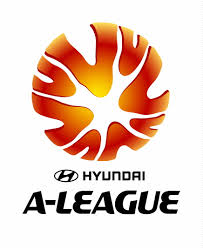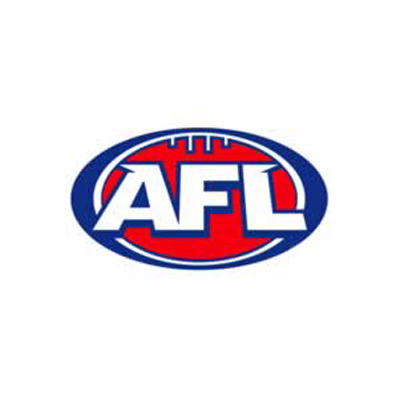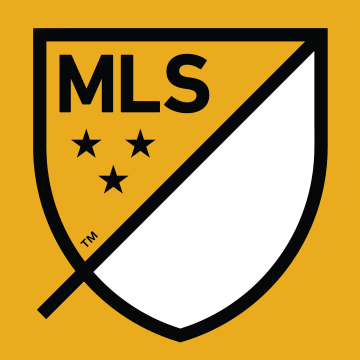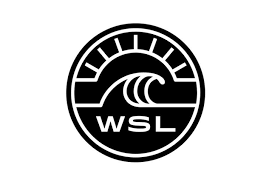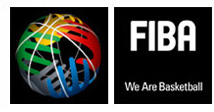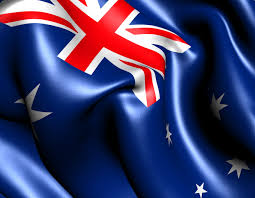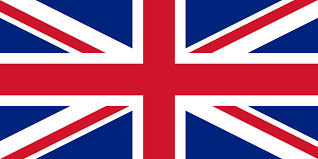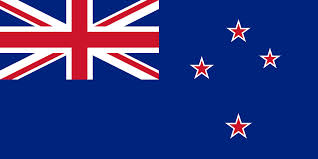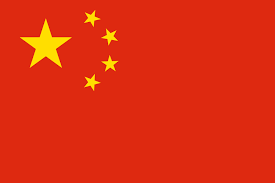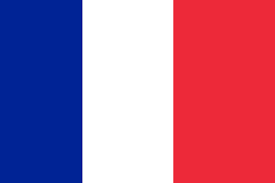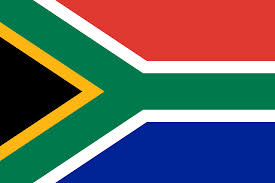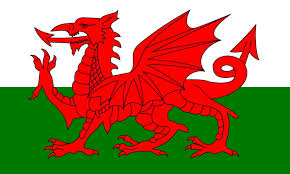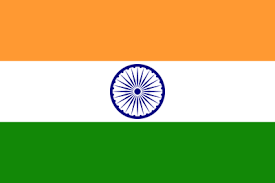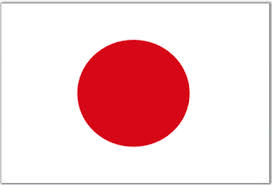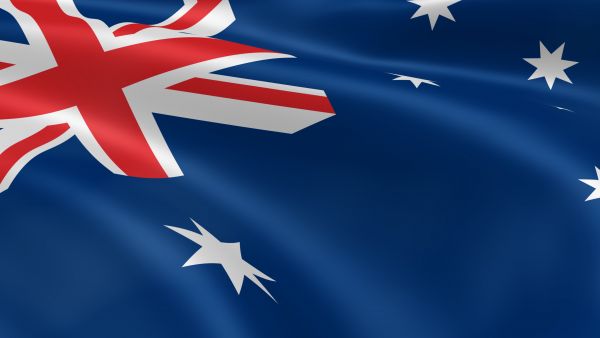International Surfing

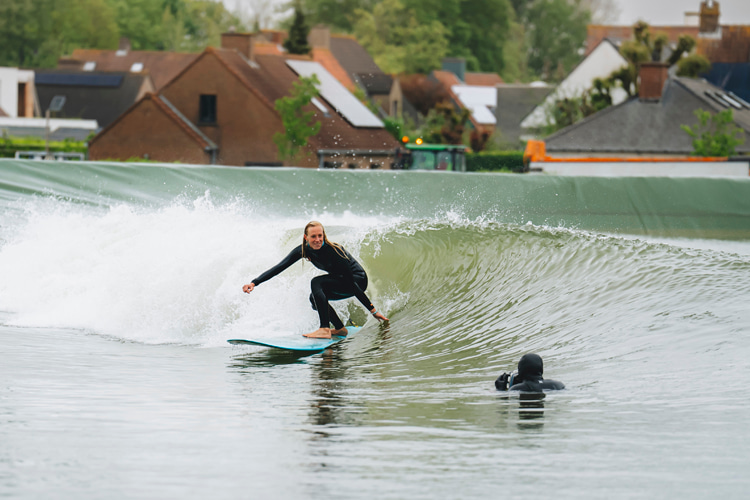
AllWaves is a new wave pool technology from Belgium that allows surfing on an artificial lake, thus bringing surfing experiences closer to enthusiasts and landlocked surfers.
The number of artificial wave generation systems is growing fast, anchored on multiple unique selling propositions: wave height, wave frequency, pool capacity, energy consumption, investment, installation time, etc.
AllWaves is a product of Belgium, a country often known for its high-end chocolate, beer, waffles, and fries.
Its natural appearance and design allow infinite wave variations, and it's the brainchild of wave energy expert and surfer Steven Nauwelaerts
In 2020, after a decade of experience in offshore energy production combined with years of exploring surf breaks from Spain to Sri Lanka, Steven partnered with his cousin and serial entrepreneur Geert Nauwelaerts to create something new.
Their goal was simple: to create the world's safest wave pool, with a natural look and feel that increases access to the sport in a predictable and controlled environment.
The system mimics the movement of ocean waves and can be adjusted to create big or small, hollow or crumbling waves, depending on the surfer's skill level.
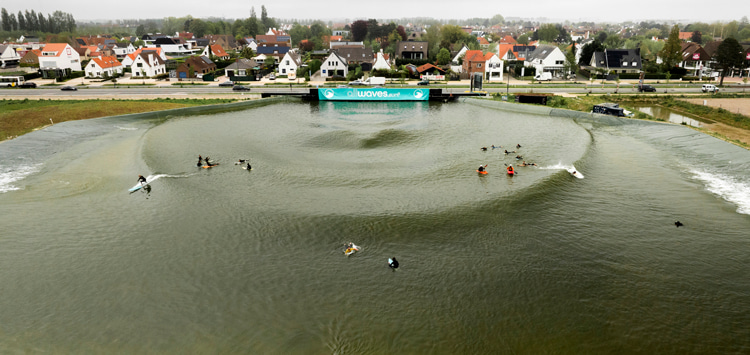
360-Degree Wave and Beaches
But how does AllWaves work? It starts with the wave itself.
At the heart is a durable textile pillow that sits on the basin floor at the center of the lagoon.
Hydraulics move the pillow up and down, pulling water toward it and pushing it away in an orbital motion, mimicking the way waves travel in the ocean.
The result is a range of waves - hence the name AllWaves - that can work for surfers of all abilities.
Height, speed, power, and wave shape are all customizable with the touch of a button.
"Our wave generation knowledge is captured in intelligent algorithms with infinite wave variability. A simple push on the app makes the desired wave roll," notes AllWaves CEO Steven Nauwelaerts.
The Belgian technology can create any wave you want, from expert barrels to softer, rolling waves that suit first-time and novice surfers.
The entire system is submerged four meters below the surface, out of harm's way and out of sight.
AllWaves uses a natural-looking lake design as its wave basin, with 360 degrees of gently sloping "beaches," just like the real thing.
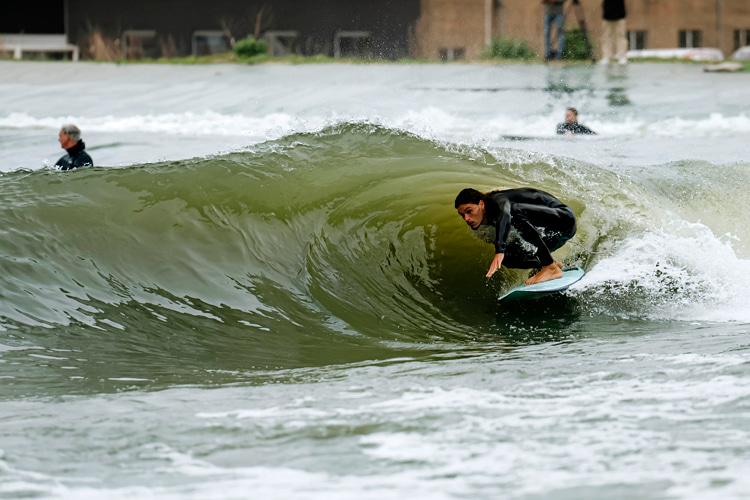
A Wave Every 7 Seconds
Surfers of every ability can enter and exit the water safely and easily. There are no vertical walls and hard corners.
The unique pool design aims to create a natural look and feel, making the experience safer and more aesthetically pleasing.
The AllWaves system generates a wave every seven seconds, with no necessary downtime to dampen wave energy.
The idea is that surfers get more waves per session, and investors witness an unparalleled return on investment (ROI).
The company claims to be able to generate waves of up to six feet (1.80 meters) in a 100-meter by 100-meter water basin that can hold 64 surfers simultaneously.
There's a left and a right-hand point break and an A-frame peak.
In addition to safety and aesthetics, AllWaves claims to be the most energy-efficient in the market.
The proprietary pillow technology uses a hydraulic system that works in resonance with the water.
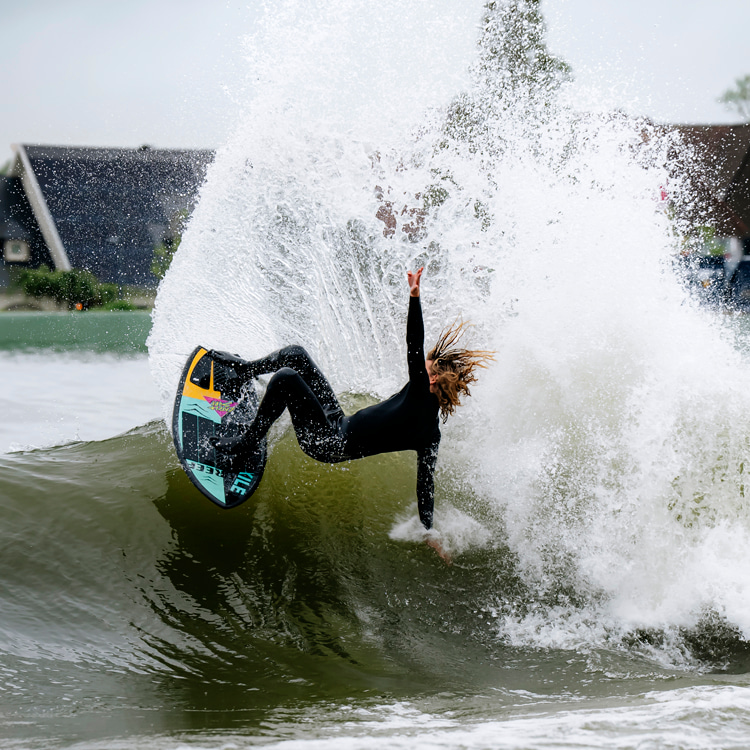
Controlled by App
Finally, AllWaves offers a lifelong guarantee.
To ensure quality and all-year-round dependability, the startup partnered with leaders in hydraulic manufacturing and high-tech textiles.
The combined impact of proven tools and machinery, which can be operated with an app, makes for reliable and user-friendly technology.
"I'm thrilled to see the positive responses of the market," adds Nauwelaerts.
"As a passionate surfer who has spent a decade working in renewable wave energy, it's a dream come true to introduce an energy-efficient wave-making technology."
Three-time United Skim Tour champion Blair Conklin and five-time world championship medalist snowboarders have already tested it.
R&D Facility Is Pumping Waves
The exact location of AllWaves' first commercial wave pool may not yet be unveiled.
Nevertheless, Steven Nauwelaerts already indicates that in addition to numerous international locations, at least one facility project will be installed in Belgium.
In 2021, in cooperation with the municipality, a location was sought for a prototype full-size wave pool, enabling a first phase of research and development activities.
The AllWaves technology is currently on display at the company's site in Natiënlaan, Knokke-Heist, Belgium, where surf park developers can witness it firsthand.
The test center powers its test waves entirely with renewable energy for a carbon-neutral footprint.
The wave pool technology's low operating costs ensure its numerous applications, ranging from recreational surf parks, water parks, and professional practice venues for surf federations to mixed-use real estate developments.
Words by Luís MP | Founder of SurferToday.com
https://www.surfertoday.com/surfing/allwaves-the-submerged-pillow-wave-technology-made-in-belgium


AllWaves is a new wave pool technology from Belgium that allows surfing on an artificial lake, thus bringing surfing experiences closer to enthusiasts and landlocked surfers.
The number of artificial wave generation systems is growing fast, anchored on multiple unique selling propositions: wave height, wave frequency, pool capacity, energy consumption, investment, installation time, etc.
AllWaves is a product of Belgium, a country often known for its high-end chocolate, beer, waffles, and fries.
Its natural appearance and design allow infinite wave variations, and it's the brainchild of wave energy expert and surfer Steven Nauwelaerts
In 2020, after a decade of experience in offshore energy production combined with years of exploring surf breaks from Spain to Sri Lanka, Steven partnered with his cousin and serial entrepreneur Geert Nauwelaerts to create something new.
Their goal was simple: to create the world's safest wave pool, with a natural look and feel that increases access to the sport in a predictable and controlled environment.
The system mimics the movement of ocean waves and can be adjusted to create big or small, hollow or crumbling waves, depending on the surfer's skill level.

360-Degree Wave and Beaches
But how does AllWaves work? It starts with the wave itself.
At the heart is a durable textile pillow that sits on the basin floor at the center of the lagoon.
Hydraulics move the pillow up and down, pulling water toward it and pushing it away in an orbital motion, mimicking the way waves travel in the ocean.
The result is a range of waves - hence the name AllWaves - that can work for surfers of all abilities.
Height, speed, power, and wave shape are all customizable with the touch of a button.
"Our wave generation knowledge is captured in intelligent algorithms with infinite wave variability. A simple push on the app makes the desired wave roll," notes AllWaves CEO Steven Nauwelaerts.
The Belgian technology can create any wave you want, from expert barrels to softer, rolling waves that suit first-time and novice surfers.
The entire system is submerged four meters below the surface, out of harm's way and out of sight.
AllWaves uses a natural-looking lake design as its wave basin, with 360 degrees of gently sloping "beaches," just like the real thing.

A Wave Every 7 Seconds
Surfers of every ability can enter and exit the water safely and easily. There are no vertical walls and hard corners.
The unique pool design aims to create a natural look and feel, making the experience safer and more aesthetically pleasing.
The AllWaves system generates a wave every seven seconds, with no necessary downtime to dampen wave energy.
The idea is that surfers get more waves per session, and investors witness an unparalleled return on investment (ROI).
The company claims to be able to generate waves of up to six feet (1.80 meters) in a 100-meter by 100-meter water basin that can hold 64 surfers simultaneously.
There's a left and a right-hand point break and an A-frame peak.
In addition to safety and aesthetics, AllWaves claims to be the most energy-efficient in the market.
The proprietary pillow technology uses a hydraulic system that works in resonance with the water.

Controlled by App
Finally, AllWaves offers a lifelong guarantee.
To ensure quality and all-year-round dependability, the startup partnered with leaders in hydraulic manufacturing and high-tech textiles.
The combined impact of proven tools and machinery, which can be operated with an app, makes for reliable and user-friendly technology.
"I'm thrilled to see the positive responses of the market," adds Nauwelaerts.
"As a passionate surfer who has spent a decade working in renewable wave energy, it's a dream come true to introduce an energy-efficient wave-making technology."
Three-time United Skim Tour champion Blair Conklin and five-time world championship medalist snowboarders have already tested it.
R&D Facility Is Pumping Waves
The exact location of AllWaves' first commercial wave pool may not yet be unveiled.
Nevertheless, Steven Nauwelaerts already indicates that in addition to numerous international locations, at least one facility project will be installed in Belgium.
In 2021, in cooperation with the municipality, a location was sought for a prototype full-size wave pool, enabling a first phase of research and development activities.
The AllWaves technology is currently on display at the company's site in Natiënlaan, Knokke-Heist, Belgium, where surf park developers can witness it firsthand.
The test center powers its test waves entirely with renewable energy for a carbon-neutral footprint.
The wave pool technology's low operating costs ensure its numerous applications, ranging from recreational surf parks, water parks, and professional practice venues for surf federations to mixed-use real estate developments.
Words by Luís MP | Founder of SurferToday.com
https://www.surfertoday.com/surfing/allwaves-the-submerged-pillow-wave-technology-made-in-belgium

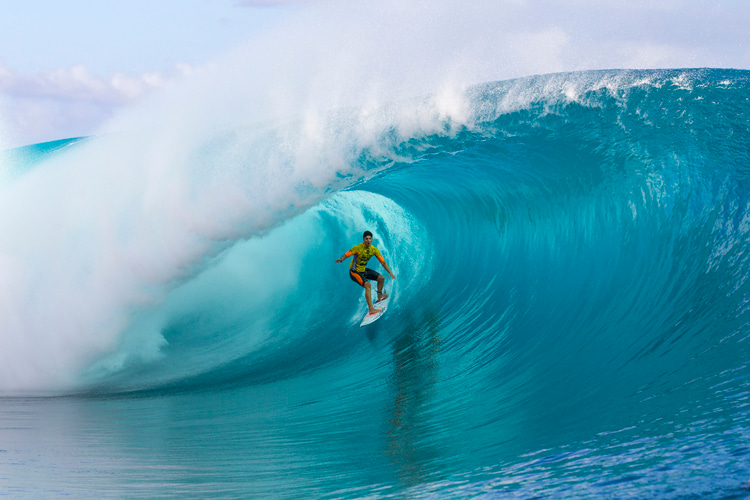
Welcome to "The End of the Road," one of the nicknames for the Paris 2024 Olympic surfing venue, Teahupoo.
Surfing is one of the most spectator-friendly Olympic sports to watch on the television or a computer screen.
After a promising debut in Tokyo 2020, shortboard surfers are set to ignite the warm, transparent Tahitian waters with eye-catching tube-riding skills and spectacular aerial maneuvers.
Here's everything you should know to follow the world's best surfers and one of the planet's biggest and most challenging waves.
The Venue: Tahiti
The Paris 2024 Olympic surfing competition will take place in the small village of Teahupo'o, southwest of Tahiti, French Polynesia.
The first person to ride the infamous surf break was Thierry Vernaudon in 1985.
He was followed by two legendary bodyboarders, Mike Stewart and Ben Severson, the first foreign riders to taste this unique and dangerous wave.
The word-of-mouth spread, and this unique tropical surfing paradise soon became one of the most sought-after surf breaks.
Teahupoo, which translates to English as "the pile of heads," "the heap of heads," or "the hot head";
The event window runs from July 27 through August 4, with the following tentative schedule:
- July 27 (1 pm - 10:30 pm): Men's Round 1 (8 Heats) and Women's Round 1 (8 Heats);
- July 28 (1 pm - 10:30 pm): Women's Round 2 (8 Heats) and Men's Round 2 (8 Heats);
- July 29 (1 pm - 10:30 pm): Men's Round 3 (8 Heats) and Women's Round 3 (8 Heats);
- July 30 (1 pm - 10:50 pm): Men's Quarterfinals, Women's Quarterfinals, Men's Semifinals, Women's Semifinals, Men's Bronze Medal Heat, Women's Bronze Medal Heat, Men's Gold Medal Heat, Women's Gold Medal Heat;
NBCUniversal and Peacock will broadcast the Paris 2024 surfing program in the United States. Cj Kirwan will be the network's correspondent at Teahupoo.
Globo (Brazil), BBC (UK), Eurosport, Max and Discovery (Europe), Nine Network (Australia), CBC (Canada), Sky (New Zealand), and many other continental and national TV networks will bring you the live coverage of every wave ridden in Tahiti.
It will be the longest distance between a venue and the host city in the Olympic Games history: 9,755 miles (15,700 kilometers).
Duke Kahanamoku (1890-1968), the father of modern surfing, was the first to campaign for the sport's inclusion in the Olympic program.
Teahupoo will host the second Olympic surfing appearance after Tsurigasaki Beach, Japan, in Tokyo 2020.
There was controversy surrounding the preparations for the 2024 Olympic surfing competition - the judging tower.
A nine-tonne aluminum scaffolding replaced the old wooden structure installed on the reef and used since 2003.
The new judging tower was considered a threat to the local fragile marine ecosystem. During its installation, a barge damaged part of the coral.
Unusual scenes and moments at The End of the Road? Sure - a surfer set on fire and getting barreled and a motorcycle rider taking on a 15-foot wave.
The Wave: Teahupoo
Teahupoo is known in the surfing world for its spectacular left-hand barreling waves, which detonate on a very shallow coral structure, sometimes slightly over a foot (30 centimeters).
The wave breaks around 500 yards off the coastline in a local reef pass.
Surfers should expect heavy, hollow, and fast-breaking waves in the 6-26-foot (1.8-8 meters) range.
Why do waves at Teahupoo get so big?
The deep, heavy liquid gem forms when the sea floor suddenly changes.
Just a little past the shallow reef, the ocean floor drops drastically, going from deep to very shallow in a short distance.
This quick change is why waves build up high over the coral before crashing down with great force.
Because of all the water moving so forcefully, the waves have a thick, heavy lip. The ride itself is relatively short in length, between 75 and 100 yards.
The lip of a wave is the part surfers, and spectators see curling over at the top.
These waves are hard to ride because they're abnormally heavy, especially with the shallow reef below.
The best time of the year to witness epic conditions at Teahupoo is between April and September, especially in the morning, with a SSW swell and NE/ESE winds.
Five surfers have died surfing Tahiti's most powerful wave. Broken vertebrae and scalp wounds are more than common injuries.
One of Teahupoo's most memorable surfing sessions occurred on August 17, 2000, when Laird Hamilton dropped into the so-called Millennium Wave.
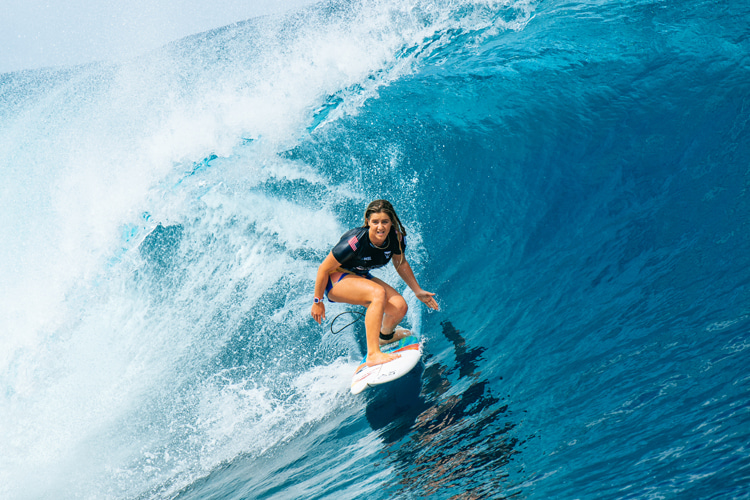
The Rules: Format, Judging, and Scoring
Paris 2024 surfers will compete in a ladder tournament-style contest for gold, medal, and bronze medals.
Round 1 features eight heats of three surfers each.
The winner of each heat moves straight to Round 3, while the other two surfers go to Round 2.
Round 2 consists of eight heats of two surfers, with the winner advancing to Round 3 and the loser getting eliminated.
Round 3 has eight single-elimination heats of two surfers, with the winner moving to the quarterfinals and the loser going home.
The four quarterfinal heats repeat the head-to-head clashes, with the winner advancing to the semifinals.
In the two semifinals, the losers compete in the bronze-medal matchup; the winners secure a place in the final.
Surfers are scored by a panel of judges on their two best waves on a scale from 0 to 10 and a maximum of 20 points.
The athlete with the highest total score wins the heat.
The duration of each heat depends on the ocean conditions and wave availability/consistency and could be set by organizers in 15-45 minutes.
Judges will mainly be looking for tube-riding skills, i.e., the time spent inside the transparent cylinders, the size of the wave, and the distance traveled in the tube.
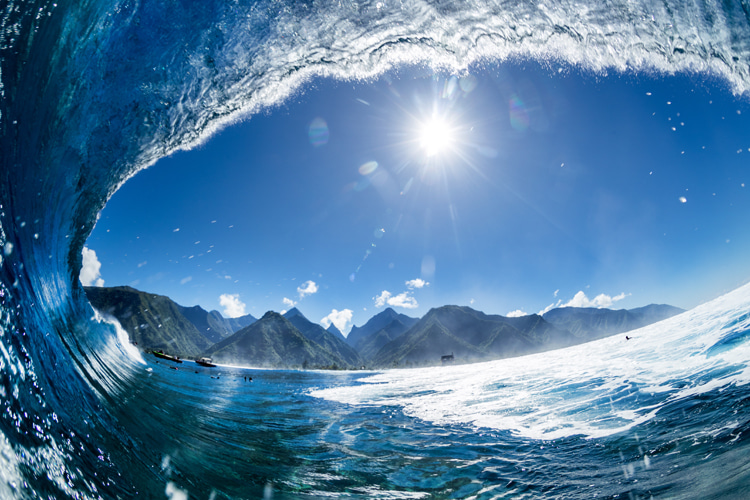
The Surfers: Names and Seeding Criteria
Surfing's qualifying period for the Paris 2024 Olympic Games runs from September 2022 to June 2024.
Athletes qualified via:
- 2022 ISA World Surfing Games (WSG);
- 2023 ISA World Surfing Games (WSG);
- Santiago 2023 Pan American Games;
- 2023 WSL Championship Tour (CT);
- 2024 ISA World Surfing Games (WSG);
The program at Teahupoo features 24 male and 24 female athletes. They are:
Men
- Kanoa Igarashi (JPN) | 2023 ISA World Surfing Games
- Jordy Smith (RSA) | 2023 ISA World Surfing Games
- Billy Stairmand (NZL) | 2023 ISA World Surfing Games
- Kauli Vaast (FRA) | 2023 ISA World Surfing Games
- Filipe Toledo (BRA) | 2023 WSL Championship Tour
- Ethan Ewing (AUS) | 2023 WSL Championship Tour
- Griffin Colapinto (USA) | 2023 WSL Championship Tour
- Leonardo Fioravanti (ITA) | 2023 WSL Championship Tour
- John John Florence (USA) | 2023 WSL Championship Tour
- Jack Robinson (AUS) | 2023 WSL Championship Tour
- Matthew McGillivray (RSA) | 2023 WSL Championship Tour
- João Chianca (BRA) | 2023 WSL Championship Tour
- Alan Cleland Jr. (MEX) | 2023 WSL Championship Tour
- Reo Inaba (JPN) | 2023 WSL Championship Tour
- Lucca Mesinas (PER) | 2023 Pan American Games
- Alonso Correa (PER) | 2024 ISA World Surfing Games
- Andy Criere (ESP) | 2024 ISA World Surfing Games
- Joan Duru (FRA) | 2024 ISA World Surfing Games
- Ramzi Boukhiam (MAR) | 2024 ISA World Surfing Games
- Rio Waida (INA) | 2024 ISA World Surfing Games
- Tim Elter (GER) | 2024 ISA World Surfing Games
- Gabriel Medina (BRA) | 2024 ISA World Surfing Games
- Bryan Perez (ESA) | Universality Allocation
Women
- Tatiana Weston-Webb (BRA) | 2023 WSL Championship Tour
- Johanne Defay (FRA) | 2023 WSL Championship Tour
- Brisa Hennessy (CRC) | 2023 WSL Championship Tour
- Teresa Bonvalot (POR) | 2023 WSL Championship Tour
- Sarah Baum (RSA) | 2023 ISA World Surfing Games
- Shino Matsuda (JPN) | 2023 ISA World Surfing Games
- Saffi Vette (NZL) | 2023 ISA World Surfing Games
- Vahine Fierro (FRA) | 2023 ISA World Surfing Games
- Carissa Moore (USA) | 2023 WSL Championship Tour
- Tyler Wright (AUS) | 2023 WSL Championship Tour
- Molly Picklum (AUS) | 2023 WSL Championship Tour
- Caroline Marks (USA) | 2023 WSL Championship Tour
- Sanoa Dempfle-Olin (CAN) | 2023 Pan American Games
- Nadia Erostarbe (ESP) | 2024 ISA World Surfing Games
- Janire Gonzalez-Extabarri (ESP) | 2024 ISA World Surfing Games
- Sol Aguirre (PER) | 2024 ISA World Surfing Games
- Tainá Hinckel (BRA) | 2024 ISA World Surfing Games
- Yolanda Hopkins (POR) | 2024 ISA World Surfing Games
- Anat Lelior (ISR) | 2024 ISA World Surfing Games
- Camilla Kemp (GER) | 2024 ISA World Surfing Games
- Siqi Yang (CHN) | 2024 ISA World Surfing Games
- Caitlin Simmers (USA) | 2024 ISA World Surfing Games
- Candelaria Resano (NCA) | Universality Allocation
The seeding criteria for the heats prioritize the surfers' results and qualifications in the following order:
- 2024 ISA World Surfing Games;
- 2023 World Surf League (WSL) Championship Tour (CT);
- Continental position;
- Team champion at the 2022 WSG;
- Team Champion at the 2024;
- Universality allocation;
Three male world surfing champions will be riding for medals at Teahupoo: Filipe Toledo, John John Florence, and Gabriel Medina.
On the women's side, there are also three world champions: Carissa Moore, Tyler Wright, and Caroline Marks.
Teaupoo is a left-hand wave, meaning that it peels and breaks from the right to the left.
Consequently, in theory, it benefits goofy-footed surfers, that is, athletes who ride with their right foot forward on the surfboard and their chest facing the wave.
Nevertheless, competitively speaking, the odds are relatively even.
Let the Games begin.
Words by Luís MP | Founder of SurferToday.com
https://www.surfertoday.com/surfing/spectators-guide-to-surfing-at-the-paris-2024-olympics-in-teahupoo


Welcome to "The End of the Road," one of the nicknames for the Paris 2024 Olympic surfing venue, Teahupoo.
Surfing is one of the most spectator-friendly Olympic sports to watch on the television or a computer screen.
After a promising debut in Tokyo 2020, shortboard surfers are set to ignite the warm, transparent Tahitian waters with eye-catching tube-riding skills and spectacular aerial maneuvers.
Here's everything you should know to follow the world's best surfers and one of the planet's biggest and most challenging waves.
The Venue: Tahiti
The Paris 2024 Olympic surfing competition will take place in the small village of Teahupo'o, southwest of Tahiti, French Polynesia.
The first person to ride the infamous surf break was Thierry Vernaudon in 1985.
He was followed by two legendary bodyboarders, Mike Stewart and Ben Severson, the first foreign riders to taste this unique and dangerous wave.
The word-of-mouth spread, and this unique tropical surfing paradise soon became one of the most sought-after surf breaks.
Teahupoo, which translates to English as "the pile of heads," "the heap of heads," or "the hot head";
The event window runs from July 27 through August 4, with the following tentative schedule:
- July 27 (1 pm - 10:30 pm): Men's Round 1 (8 Heats) and Women's Round 1 (8 Heats);
- July 28 (1 pm - 10:30 pm): Women's Round 2 (8 Heats) and Men's Round 2 (8 Heats);
- July 29 (1 pm - 10:30 pm): Men's Round 3 (8 Heats) and Women's Round 3 (8 Heats);
- July 30 (1 pm - 10:50 pm): Men's Quarterfinals, Women's Quarterfinals, Men's Semifinals, Women's Semifinals, Men's Bronze Medal Heat, Women's Bronze Medal Heat, Men's Gold Medal Heat, Women's Gold Medal Heat;
NBCUniversal and Peacock will broadcast the Paris 2024 surfing program in the United States. Cj Kirwan will be the network's correspondent at Teahupoo.
Globo (Brazil), BBC (UK), Eurosport, Max and Discovery (Europe), Nine Network (Australia), CBC (Canada), Sky (New Zealand), and many other continental and national TV networks will bring you the live coverage of every wave ridden in Tahiti.
It will be the longest distance between a venue and the host city in the Olympic Games history: 9,755 miles (15,700 kilometers).
Duke Kahanamoku (1890-1968), the father of modern surfing, was the first to campaign for the sport's inclusion in the Olympic program.
Teahupoo will host the second Olympic surfing appearance after Tsurigasaki Beach, Japan, in Tokyo 2020.
There was controversy surrounding the preparations for the 2024 Olympic surfing competition - the judging tower.
A nine-tonne aluminum scaffolding replaced the old wooden structure installed on the reef and used since 2003.
The new judging tower was considered a threat to the local fragile marine ecosystem. During its installation, a barge damaged part of the coral.
Unusual scenes and moments at The End of the Road? Sure - a surfer set on fire and getting barreled and a motorcycle rider taking on a 15-foot wave.
The Wave: Teahupoo
Teahupoo is known in the surfing world for its spectacular left-hand barreling waves, which detonate on a very shallow coral structure, sometimes slightly over a foot (30 centimeters).
The wave breaks around 500 yards off the coastline in a local reef pass.
Surfers should expect heavy, hollow, and fast-breaking waves in the 6-26-foot (1.8-8 meters) range.
Why do waves at Teahupoo get so big?
The deep, heavy liquid gem forms when the sea floor suddenly changes.
Just a little past the shallow reef, the ocean floor drops drastically, going from deep to very shallow in a short distance.
This quick change is why waves build up high over the coral before crashing down with great force.
Because of all the water moving so forcefully, the waves have a thick, heavy lip. The ride itself is relatively short in length, between 75 and 100 yards.
The lip of a wave is the part surfers, and spectators see curling over at the top.
These waves are hard to ride because they're abnormally heavy, especially with the shallow reef below.
The best time of the year to witness epic conditions at Teahupoo is between April and September, especially in the morning, with a SSW swell and NE/ESE winds.
Five surfers have died surfing Tahiti's most powerful wave. Broken vertebrae and scalp wounds are more than common injuries.
One of Teahupoo's most memorable surfing sessions occurred on August 17, 2000, when Laird Hamilton dropped into the so-called Millennium Wave.

The Rules: Format, Judging, and Scoring
Paris 2024 surfers will compete in a ladder tournament-style contest for gold, medal, and bronze medals.
Round 1 features eight heats of three surfers each.
The winner of each heat moves straight to Round 3, while the other two surfers go to Round 2.
Round 2 consists of eight heats of two surfers, with the winner advancing to Round 3 and the loser getting eliminated.
Round 3 has eight single-elimination heats of two surfers, with the winner moving to the quarterfinals and the loser going home.
The four quarterfinal heats repeat the head-to-head clashes, with the winner advancing to the semifinals.
In the two semifinals, the losers compete in the bronze-medal matchup; the winners secure a place in the final.
Surfers are scored by a panel of judges on their two best waves on a scale from 0 to 10 and a maximum of 20 points.
The athlete with the highest total score wins the heat.
The duration of each heat depends on the ocean conditions and wave availability/consistency and could be set by organizers in 15-45 minutes.
Judges will mainly be looking for tube-riding skills, i.e., the time spent inside the transparent cylinders, the size of the wave, and the distance traveled in the tube.

The Surfers: Names and Seeding Criteria
Surfing's qualifying period for the Paris 2024 Olympic Games runs from September 2022 to June 2024.
Athletes qualified via:
- 2022 ISA World Surfing Games (WSG);
- 2023 ISA World Surfing Games (WSG);
- Santiago 2023 Pan American Games;
- 2023 WSL Championship Tour (CT);
- 2024 ISA World Surfing Games (WSG);
The program at Teahupoo features 24 male and 24 female athletes. They are:
Men
- Kanoa Igarashi (JPN) | 2023 ISA World Surfing Games
- Jordy Smith (RSA) | 2023 ISA World Surfing Games
- Billy Stairmand (NZL) | 2023 ISA World Surfing Games
- Kauli Vaast (FRA) | 2023 ISA World Surfing Games
- Filipe Toledo (BRA) | 2023 WSL Championship Tour
- Ethan Ewing (AUS) | 2023 WSL Championship Tour
- Griffin Colapinto (USA) | 2023 WSL Championship Tour
- Leonardo Fioravanti (ITA) | 2023 WSL Championship Tour
- John John Florence (USA) | 2023 WSL Championship Tour
- Jack Robinson (AUS) | 2023 WSL Championship Tour
- Matthew McGillivray (RSA) | 2023 WSL Championship Tour
- João Chianca (BRA) | 2023 WSL Championship Tour
- Alan Cleland Jr. (MEX) | 2023 WSL Championship Tour
- Reo Inaba (JPN) | 2023 WSL Championship Tour
- Lucca Mesinas (PER) | 2023 Pan American Games
- Alonso Correa (PER) | 2024 ISA World Surfing Games
- Andy Criere (ESP) | 2024 ISA World Surfing Games
- Joan Duru (FRA) | 2024 ISA World Surfing Games
- Ramzi Boukhiam (MAR) | 2024 ISA World Surfing Games
- Rio Waida (INA) | 2024 ISA World Surfing Games
- Tim Elter (GER) | 2024 ISA World Surfing Games
- Gabriel Medina (BRA) | 2024 ISA World Surfing Games
- Bryan Perez (ESA) | Universality Allocation
Women
- Tatiana Weston-Webb (BRA) | 2023 WSL Championship Tour
- Johanne Defay (FRA) | 2023 WSL Championship Tour
- Brisa Hennessy (CRC) | 2023 WSL Championship Tour
- Teresa Bonvalot (POR) | 2023 WSL Championship Tour
- Sarah Baum (RSA) | 2023 ISA World Surfing Games
- Shino Matsuda (JPN) | 2023 ISA World Surfing Games
- Saffi Vette (NZL) | 2023 ISA World Surfing Games
- Vahine Fierro (FRA) | 2023 ISA World Surfing Games
- Carissa Moore (USA) | 2023 WSL Championship Tour
- Tyler Wright (AUS) | 2023 WSL Championship Tour
- Molly Picklum (AUS) | 2023 WSL Championship Tour
- Caroline Marks (USA) | 2023 WSL Championship Tour
- Sanoa Dempfle-Olin (CAN) | 2023 Pan American Games
- Nadia Erostarbe (ESP) | 2024 ISA World Surfing Games
- Janire Gonzalez-Extabarri (ESP) | 2024 ISA World Surfing Games
- Sol Aguirre (PER) | 2024 ISA World Surfing Games
- Tainá Hinckel (BRA) | 2024 ISA World Surfing Games
- Yolanda Hopkins (POR) | 2024 ISA World Surfing Games
- Anat Lelior (ISR) | 2024 ISA World Surfing Games
- Camilla Kemp (GER) | 2024 ISA World Surfing Games
- Siqi Yang (CHN) | 2024 ISA World Surfing Games
- Caitlin Simmers (USA) | 2024 ISA World Surfing Games
- Candelaria Resano (NCA) | Universality Allocation
The seeding criteria for the heats prioritize the surfers' results and qualifications in the following order:
- 2024 ISA World Surfing Games;
- 2023 World Surf League (WSL) Championship Tour (CT);
- Continental position;
- Team champion at the 2022 WSG;
- Team Champion at the 2024;
- Universality allocation;
Three male world surfing champions will be riding for medals at Teahupoo: Filipe Toledo, John John Florence, and Gabriel Medina.
On the women's side, there are also three world champions: Carissa Moore, Tyler Wright, and Caroline Marks.
Teaupoo is a left-hand wave, meaning that it peels and breaks from the right to the left.
Consequently, in theory, it benefits goofy-footed surfers, that is, athletes who ride with their right foot forward on the surfboard and their chest facing the wave.
Nevertheless, competitively speaking, the odds are relatively even.
Let the Games begin.
Words by Luís MP | Founder of SurferToday.com
https://www.surfertoday.com/surfing/spectators-guide-to-surfing-at-the-paris-2024-olympics-in-teahupoo

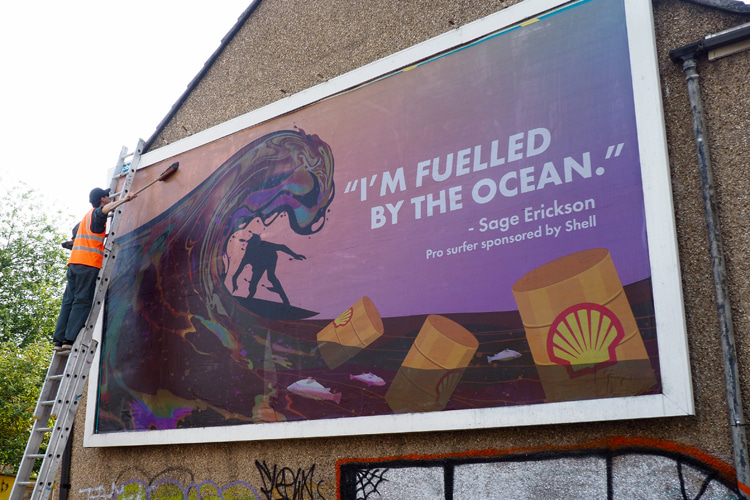
Activists from the anonymous Brandalism collective have replaced more than 200 commercial adverts across London, Manchester, and Bristol with satirical artworks protesting Shell's efforts to "fast track the apocalypse" ahead of the oil major's annual general meeting (AGM) in London.
Brandalism's clandestine installation of satirical posters on billboards, bus stops, and tube carriages aims at Shell's marketing strategies to maintain its reputation during its expanding fossil fuel production and recent u-turns on green pledges.
Several poster artworks, designed by nine artists, critique Shell's sponsorship of athletes and sports and its targeting of youth culture, which the group says are PR tactics reminiscent of the tobacco industry.
One by artist and surfer Michelle Tylicki shows American pro surfer Sage Erickson surfing over dead fish and oil drums in a multicolored oil slick, and the words "I'm Fuelled by the Ocean."
It's a direct quote from Erickson's "Unbound Diaries" Instagram posts branded with the Shell logo.
"As someone who finds solace in riding waves, to me this quote by pro surfer Sage Erickson, which featured in Shell-sponsored Instagram posts, felt deeply insulting," says Michelle Tylicki, the artist behind the "I'm Fuelled by the Ocean" billboard artwork.
"Shell continues to hack youth culture by tapping up influencers and is benefiting from associating with the world of surfing - its clean ocean imagery and the promise of adventure."
"In fact, Shell has become the most prominent employer of influencer advertising over the last seven years."
"But all the while, Shell is heavily polluting the oceans with oil spills and millions of tons of petroleum hydrocarbon-based plastic."
"Shell has no place in surfing or using athletes to push their harmful products on younger audiences."
"My sickly multicolored oil slick wave demonstrates where the oceans are heading if we keep letting Shell get away with this."
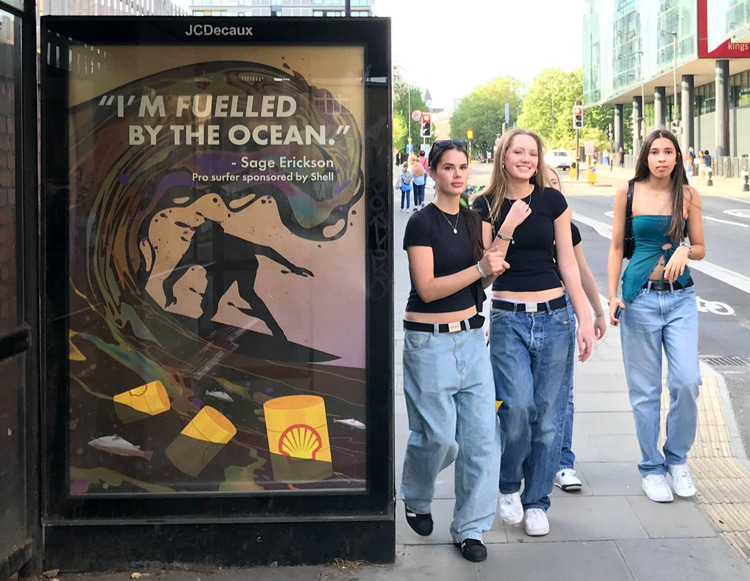
"How Do You Sell Death?"
The artists and activists involved in Brandalism are calling for athletes, sports organizations, shareholders, municipalities, and advertising agencies to reject money from Shell and other fossil fuel companies to clear the way for climate action.
"To quote the tobacco marketers of the 1980s, 'The problem is how do you sell death?'" adds Tona Merriman from Brandalism.
"Shell is on a mission to sell its own lethal legacy, using influencers, greenwash advertising, sports sponsorship, and political connections to deflect attention from its growing contribution to climate breakdown, which is reversing decades of progress in health and causing death and destruction worldwide."
"Shell's insidious tactics are straight out of Big Tobacco's playbook, enabled by a toxic coterie of advertising and PR agencies who should be helping to kick fossil fuel companies into history, not boosting their brand."
A recent analysis by Global Witness suggests that emissions from fossil fuels produced by Shell and four other top oil and gas firms could result in 11.5 million excess deaths from heat by 2100.
Shell alone is responsible for around 1.2 percent of all global emissions between 2016 and 2022, with the firm's contribution to climate change dating back to 1897.
Shell CEO Wael Sawan has rowed back on green pledges amid rocketing profits, saying he wants to "reward our shareholders."
In early May 2024, Shell reported first-quarter profits of $8 bn (£6.15 bn).
Commenting on the Brandalism action, Freddie Daley from the Badvertising campaign, who is calling for a tobacco-style ban on fossil fuel advertising, said: "In recent years, Shell has shown that it has no intention of building a low-carbon energy system and a habitable future."
"By using sports sponsorship, lobbying, and social media influencers, Shell is desperate to maintain its reputation as the firm cash in on climate chaos."
"The only way to break this cycle of misinformation and underhand tactics is to bring in tobacco-style restrictions on fossil fuel advertising."
In 2023, the UK ad watchdog banned a series of Shell ads for greenwashing.
The ads overemphasized Shell's investment in renewable energy and failed to mention its large-scale and expanding fossil fuel activities.
Shell's latest climate strategy, which has been denounced as weak, will be voted on by shareholders at its London AGM on May 21, 2024.
https://www.surfertoday.com/surfing/oil-giant-shell-surf-sponsorships-under-fire-in-uk-guerrilla-billboard-protest


Activists from the anonymous Brandalism collective have replaced more than 200 commercial adverts across London, Manchester, and Bristol with satirical artworks protesting Shell's efforts to "fast track the apocalypse" ahead of the oil major's annual general meeting (AGM) in London.
Brandalism's clandestine installation of satirical posters on billboards, bus stops, and tube carriages aims at Shell's marketing strategies to maintain its reputation during its expanding fossil fuel production and recent u-turns on green pledges.
Several poster artworks, designed by nine artists, critique Shell's sponsorship of athletes and sports and its targeting of youth culture, which the group says are PR tactics reminiscent of the tobacco industry.
One by artist and surfer Michelle Tylicki shows American pro surfer Sage Erickson surfing over dead fish and oil drums in a multicolored oil slick, and the words "I'm Fuelled by the Ocean."
It's a direct quote from Erickson's "Unbound Diaries" Instagram posts branded with the Shell logo.
"As someone who finds solace in riding waves, to me this quote by pro surfer Sage Erickson, which featured in Shell-sponsored Instagram posts, felt deeply insulting," says Michelle Tylicki, the artist behind the "I'm Fuelled by the Ocean" billboard artwork.
"Shell continues to hack youth culture by tapping up influencers and is benefiting from associating with the world of surfing - its clean ocean imagery and the promise of adventure."
"In fact, Shell has become the most prominent employer of influencer advertising over the last seven years."
"But all the while, Shell is heavily polluting the oceans with oil spills and millions of tons of petroleum hydrocarbon-based plastic."
"Shell has no place in surfing or using athletes to push their harmful products on younger audiences."
"My sickly multicolored oil slick wave demonstrates where the oceans are heading if we keep letting Shell get away with this."

"How Do You Sell Death?"
The artists and activists involved in Brandalism are calling for athletes, sports organizations, shareholders, municipalities, and advertising agencies to reject money from Shell and other fossil fuel companies to clear the way for climate action.
"To quote the tobacco marketers of the 1980s, 'The problem is how do you sell death?'" adds Tona Merriman from Brandalism.
"Shell is on a mission to sell its own lethal legacy, using influencers, greenwash advertising, sports sponsorship, and political connections to deflect attention from its growing contribution to climate breakdown, which is reversing decades of progress in health and causing death and destruction worldwide."
"Shell's insidious tactics are straight out of Big Tobacco's playbook, enabled by a toxic coterie of advertising and PR agencies who should be helping to kick fossil fuel companies into history, not boosting their brand."
A recent analysis by Global Witness suggests that emissions from fossil fuels produced by Shell and four other top oil and gas firms could result in 11.5 million excess deaths from heat by 2100.
Shell alone is responsible for around 1.2 percent of all global emissions between 2016 and 2022, with the firm's contribution to climate change dating back to 1897.
Shell CEO Wael Sawan has rowed back on green pledges amid rocketing profits, saying he wants to "reward our shareholders."
In early May 2024, Shell reported first-quarter profits of $8 bn (£6.15 bn).
Commenting on the Brandalism action, Freddie Daley from the Badvertising campaign, who is calling for a tobacco-style ban on fossil fuel advertising, said: "In recent years, Shell has shown that it has no intention of building a low-carbon energy system and a habitable future."
"By using sports sponsorship, lobbying, and social media influencers, Shell is desperate to maintain its reputation as the firm cash in on climate chaos."
"The only way to break this cycle of misinformation and underhand tactics is to bring in tobacco-style restrictions on fossil fuel advertising."
In 2023, the UK ad watchdog banned a series of Shell ads for greenwashing.
The ads overemphasized Shell's investment in renewable energy and failed to mention its large-scale and expanding fossil fuel activities.
Shell's latest climate strategy, which has been denounced as weak, will be voted on by shareholders at its London AGM on May 21, 2024.
https://www.surfertoday.com/surfing/oil-giant-shell-surf-sponsorships-under-fire-in-uk-guerrilla-billboard-protest

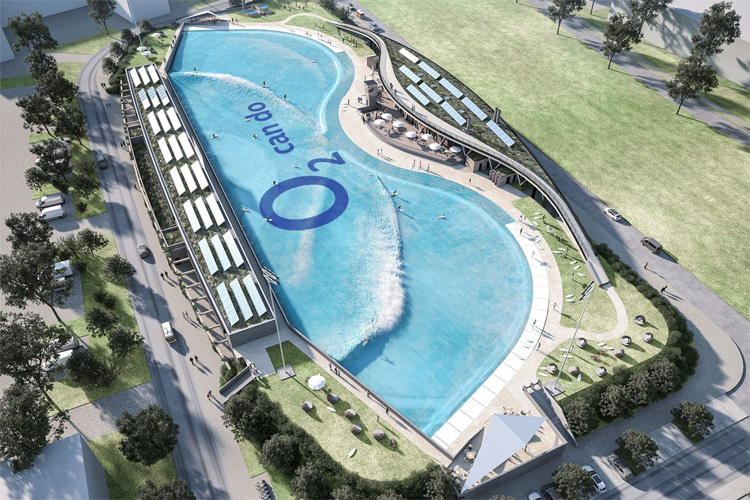
The waves at O2 SurfTown MUC are rolling. Europe's largest wave pool opens in Summer 2024 in Munich, Germany.
The basin has been filled with water, and the 34 pneumatic chamber machines have produced the first artificial waves.
Endless Surf, a wave generation technology powered by WhiteWater, is making its grand debut with a stadium-sized surf lagoon in the capital of Bavaria.
SurfTown MUC is a 180-meter-long wave pool featuring four different surf zones, each allowing a maximum of 16 surfers simultaneously.
It's over 50 percent longer in length than a football pitch.
The one-hour sessions guarantee a minimum of 12 wave ride attempts per surfer.
The Munich wave pool will be open seven days a week, all year round.
During summer, it opens at 7 am and closes at 10 pm. In winter, only extreme weather conditions may force closures.
The non-heated water temperature will be around 24 °C (75 °F) in the warm season and potentially below 10 °C (50 °F) in wintertime.
Up to 2.1-meter Waves
There are seven different wave heights for seven different experience levels. They are:
- First-timer: 0.5 meters;
- Rookie: 0.7 meters;
- Progressive: 1.0 meters;
- Intermediate: 1.4 meters;
- Advanced: 1.7 meters;
- Expert: 1.9 meters;
- Pro: 2.1 meters;
Surfers choosing levels from First-timer to Advanced will be coached and/or guided by staff into the human-made wave.
They will provide safety, support, and technical guidance.
Whenever a surfer completes a ride, they have two ways to return to the central lineup, both of which are located on the outer limits of the wave pool.
The technology developed by Endless Surf generates all the types of waves found in the ocean, the natural environment.
There are barrels, air sections, mellow longboarding ripples, two point breaks, and a challenging A-frame peak.
The left and right point breaks create an 18-second long wave that peels across the entire wave pool length, with multiple workable sections.
The A-frame zone features a central peak that allows surfers to go left or right in waves running along the generator.
There are also two warm-up areas where surfers can prepare, stretch, gear up, and have safety briefings.
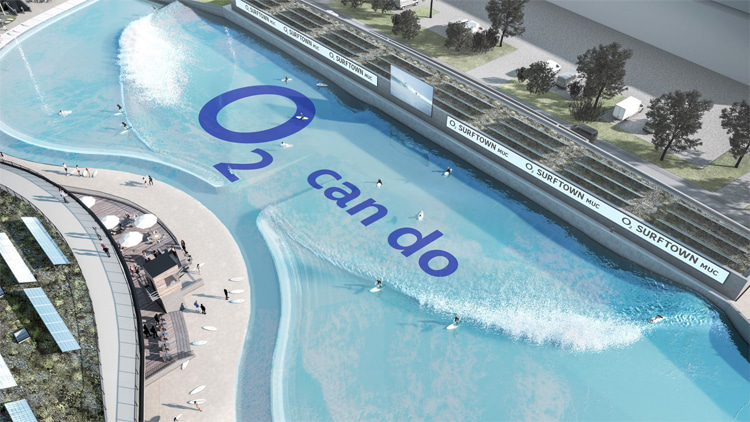
Sustainable From Birth to Operation
Sustainability was and is at the core of SurfTown MUC operation.
The mega-structure was built near good, existing public transport connections in a non-conservation area.
The wave pool is connected to a photovoltaic park and uses stored energy at night and on days of little sun exposure.
The planned degree of self-sufficiency is a minimum of 80 percent.
The closed-water system uses less chlorine than standard swimming pools, and the cooling and heating of the main building uses geothermal energy.
The maintenance of the lagoon's water does not require emptying and refilling, and the wave generation is adapted to the real-time usage and capacity.
The presale 10, 25, and 50 surf session packages sold out, with prices of €749, €1,699, and €2,899, respectively.
The single, presale A-frame surf session costs €79.
Words by Luís MP | Founder of SurferToday.com
https://www.surfertoday.com/surfing/surftown-muc-wave-pool-powered-by-endless-surf-ignites-munich


The waves at O2 SurfTown MUC are rolling. Europe's largest wave pool opens in Summer 2024 in Munich, Germany.
The basin has been filled with water, and the 34 pneumatic chamber machines have produced the first artificial waves.
Endless Surf, a wave generation technology powered by WhiteWater, is making its grand debut with a stadium-sized surf lagoon in the capital of Bavaria.
SurfTown MUC is a 180-meter-long wave pool featuring four different surf zones, each allowing a maximum of 16 surfers simultaneously.
It's over 50 percent longer in length than a football pitch.
The one-hour sessions guarantee a minimum of 12 wave ride attempts per surfer.
The Munich wave pool will be open seven days a week, all year round.
During summer, it opens at 7 am and closes at 10 pm. In winter, only extreme weather conditions may force closures.
The non-heated water temperature will be around 24 °C (75 °F) in the warm season and potentially below 10 °C (50 °F) in wintertime.
Up to 2.1-meter Waves
There are seven different wave heights for seven different experience levels. They are:
- First-timer: 0.5 meters;
- Rookie: 0.7 meters;
- Progressive: 1.0 meters;
- Intermediate: 1.4 meters;
- Advanced: 1.7 meters;
- Expert: 1.9 meters;
- Pro: 2.1 meters;
Surfers choosing levels from First-timer to Advanced will be coached and/or guided by staff into the human-made wave.
They will provide safety, support, and technical guidance.
Whenever a surfer completes a ride, they have two ways to return to the central lineup, both of which are located on the outer limits of the wave pool.
The technology developed by Endless Surf generates all the types of waves found in the ocean, the natural environment.
There are barrels, air sections, mellow longboarding ripples, two point breaks, and a challenging A-frame peak.
The left and right point breaks create an 18-second long wave that peels across the entire wave pool length, with multiple workable sections.
The A-frame zone features a central peak that allows surfers to go left or right in waves running along the generator.
There are also two warm-up areas where surfers can prepare, stretch, gear up, and have safety briefings.

Sustainable From Birth to Operation
Sustainability was and is at the core of SurfTown MUC operation.
The mega-structure was built near good, existing public transport connections in a non-conservation area.
The wave pool is connected to a photovoltaic park and uses stored energy at night and on days of little sun exposure.
The planned degree of self-sufficiency is a minimum of 80 percent.
The closed-water system uses less chlorine than standard swimming pools, and the cooling and heating of the main building uses geothermal energy.
The maintenance of the lagoon's water does not require emptying and refilling, and the wave generation is adapted to the real-time usage and capacity.
The presale 10, 25, and 50 surf session packages sold out, with prices of €749, €1,699, and €2,899, respectively.
The single, presale A-frame surf session costs €79.
Words by Luís MP | Founder of SurferToday.com
https://www.surfertoday.com/surfing/surftown-muc-wave-pool-powered-by-endless-surf-ignites-munich

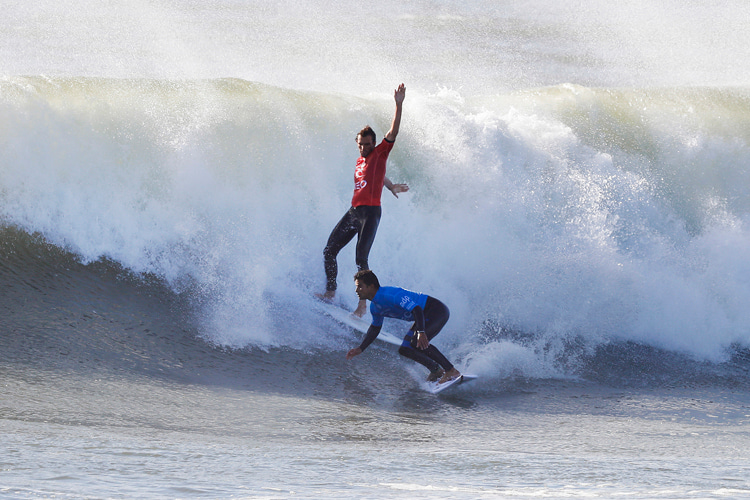
If you exclude the tandem surfing discipline, competitively speaking, surfing is often portrayed as an individual sport.
Also, it's one of those sports in which you rely more on what you do than on what your opponent is doing.
Surfers competing in a contest are supposed to perform well enough in front of a judging panel to earn high scores and progress through the ladder tournament-style event format.
You expect a surfer wearing a jersey to focus on what they can do on a wave better than anyone else, particularly their heat opponents.
So, surfing is unlike tennis, judo, boxing, or even chess, in which individuals interact directly with their opponents to try and win a game or a combat.
However, in competitive surfing, doing your best to win does not mean you don't have to worry about your opponent.
Not only you do, but you should.
In other words, surfers can prevent their opponents from taking the best waves in order to block their chances of maximizing their scoring potential.
That's when we enter the sport's tactical and strategy component that often decides heat wins, event trophies, and world titles.
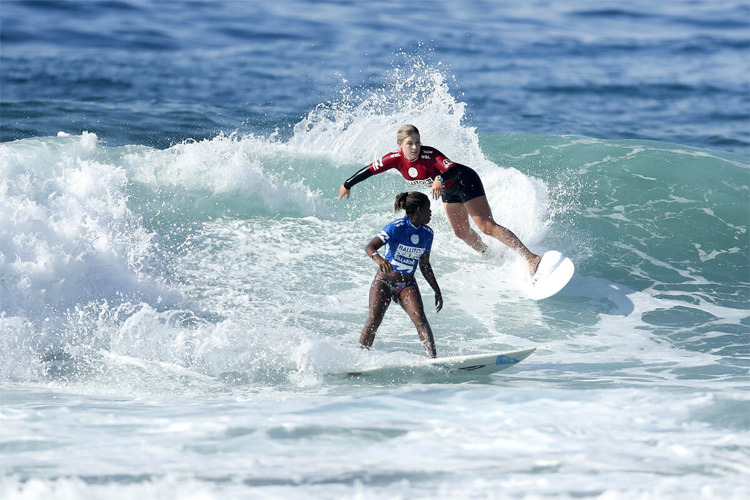
Surfing With or Against?
Competitive surfing is about skills, tactics, and having a plan for the person, sportspeople, and ocean conditions you face.
Shooting is an individual Olympic sport.
However, despite competing against fellow shooters, the athlete focuses solely on his target and can do nothing to affect the adversaries.
In surfing, when you're watching a contest, there's more than meets the eye.
An athlete can actually hinder someone's two-wave total, knowing that penalties like loss of priority and one of their two scores halved/zeroed will apply.
It's called interference. The rules differ depending on whether it's a World Surf League (WSL) or International Surfing Association (ISA) event.
So how could an interference be sufficiently appealing or worth it for surfers to actually think it's the best possible option at a given moment?
Intentional interferences are relatively rare in competitive surfing, but they've occurred with impactful consequences.
The goal is always clear: hinder someone's scoring potential on a wave.
In the vast majority of situations, "crime" doesn't pay. But when it does, it can, for instance, change a career.
The Juniors Case Study
The 2024 ISA World Junior Championship had an unusual incident that unfolded in heat 3 of the repechage Round 5.
Four surfers were in the water: Rachel Agüero from Costa Rica, Willoy Hardy from Australia, and Maria Salgado and Erica Maximo from Portugal.
With 50 seconds remaining on the clock, Agüero was first, Salgado was second, Máximo was third, and Hardy was fourth.
Despite being in the last place, the Australian only needed a 2.4 score to get second and progress.
Both the Australian and Portuguese surfers positioned themselves on the inside. A good wave approached.
Seizing the opportunity, Hardy caught it in the final seconds.
However, the Portuguese competitor in the white jersey attempted to impede the Australian's progress.
According to the Irukandjis, the Australian Surfing Team, Máximo attempted to push Hardy off her board and yelled verbal abuse before trying to grab Hardy's leash.
Despite Máximo's surprisingly aggressive tactics, the Australian was able to complete the ride and earned the score she needed to advance to the next stage.
The unsporting conduct shocked organizers, athletes, fans, and even the athlete's team and national surfing federation.
There's more to Maximo's behavior than the raw brutality of the images.
She wanted to help her teammate - and ultimately her country - to move through to the next stage by sacrificing her heat and her reputation.
Although an unacceptable, unsporting behavior, it certainly was a momentary loss of an acceptable tactical compass.
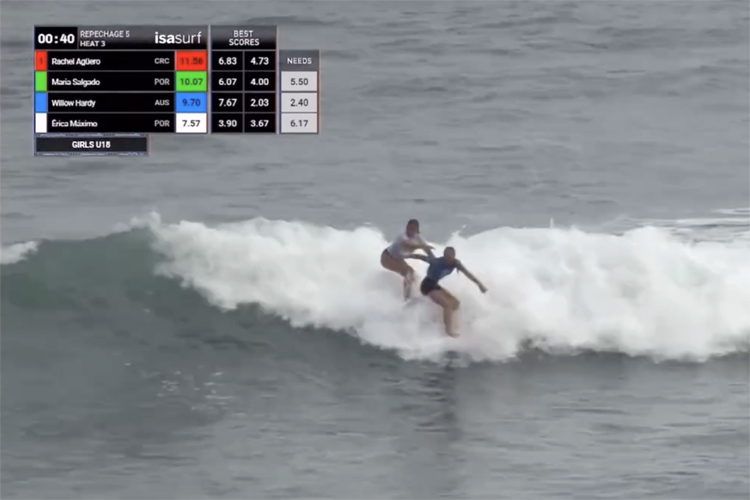
When Surfing Becomes a Team Sport
In rugby, several obstruction laws regulate what players can and cannot do.
For instance, they can tackle a player possessing the ball but cannot deliberately impede or obstruct opponents from pursuing it.
The ISA World Surfing Games and the ISA World Junior Championship introduce the team element to competitive surfing.
There's the team world champions title and the Aloha Cup winners.
Simultaneously, surfers compete individually with a strong sense of nationality and belonging to a team backing them up and waving flags on the beach.
The decision to protect, defend, or support - whatever you want to call it - a fellow countryperson is almost instinctive and second nature.
All within fair sense boundaries, obviously.
The young Portuguese surfer quickly realized she had made a mistake and issued a public and honest apology in a video punctuated by heartfelt tears.
Máximo will surely have plenty of opportunities to unveil all her surfing and sportsmanship.
Everybody makes mistakes, and we have all done (or thought) worse throughout our lives.
The only reflection the incident brought to the surface is the role of tactics and strategy in surfing as a sometimes near-team sport.
The dilemma is present, for instance, in Formula 1.
Should a Ferrari F1 driver let his teammate overtake him because he needs more points than the sacrificed driver?
What is the role and weight of the individual in a two-person team?
And what is the impact of the national flag in assessing real-time ethical-based decisions?
Can all winning rules be poured into a sport's rulebook? What is my and your gray area?
Words by Luís MP | Founder of SurferToday.com
https://www.surfertoday.com/surfing/tactics-strategy-and-ethical-dilemmas-in-competitive-surfing


If you exclude the tandem surfing discipline, competitively speaking, surfing is often portrayed as an individual sport.
Also, it's one of those sports in which you rely more on what you do than on what your opponent is doing.
Surfers competing in a contest are supposed to perform well enough in front of a judging panel to earn high scores and progress through the ladder tournament-style event format.
You expect a surfer wearing a jersey to focus on what they can do on a wave better than anyone else, particularly their heat opponents.
So, surfing is unlike tennis, judo, boxing, or even chess, in which individuals interact directly with their opponents to try and win a game or a combat.
However, in competitive surfing, doing your best to win does not mean you don't have to worry about your opponent.
Not only you do, but you should.
In other words, surfers can prevent their opponents from taking the best waves in order to block their chances of maximizing their scoring potential.
That's when we enter the sport's tactical and strategy component that often decides heat wins, event trophies, and world titles.

Surfing With or Against?
Competitive surfing is about skills, tactics, and having a plan for the person, sportspeople, and ocean conditions you face.
Shooting is an individual Olympic sport.
However, despite competing against fellow shooters, the athlete focuses solely on his target and can do nothing to affect the adversaries.
In surfing, when you're watching a contest, there's more than meets the eye.
An athlete can actually hinder someone's two-wave total, knowing that penalties like loss of priority and one of their two scores halved/zeroed will apply.
It's called interference. The rules differ depending on whether it's a World Surf League (WSL) or International Surfing Association (ISA) event.
So how could an interference be sufficiently appealing or worth it for surfers to actually think it's the best possible option at a given moment?
Intentional interferences are relatively rare in competitive surfing, but they've occurred with impactful consequences.
The goal is always clear: hinder someone's scoring potential on a wave.
In the vast majority of situations, "crime" doesn't pay. But when it does, it can, for instance, change a career.
The Juniors Case Study
The 2024 ISA World Junior Championship had an unusual incident that unfolded in heat 3 of the repechage Round 5.
Four surfers were in the water: Rachel Agüero from Costa Rica, Willoy Hardy from Australia, and Maria Salgado and Erica Maximo from Portugal.
With 50 seconds remaining on the clock, Agüero was first, Salgado was second, Máximo was third, and Hardy was fourth.
Despite being in the last place, the Australian only needed a 2.4 score to get second and progress.
Both the Australian and Portuguese surfers positioned themselves on the inside. A good wave approached.
Seizing the opportunity, Hardy caught it in the final seconds.
However, the Portuguese competitor in the white jersey attempted to impede the Australian's progress.
According to the Irukandjis, the Australian Surfing Team, Máximo attempted to push Hardy off her board and yelled verbal abuse before trying to grab Hardy's leash.
Despite Máximo's surprisingly aggressive tactics, the Australian was able to complete the ride and earned the score she needed to advance to the next stage.
The unsporting conduct shocked organizers, athletes, fans, and even the athlete's team and national surfing federation.
There's more to Maximo's behavior than the raw brutality of the images.
She wanted to help her teammate - and ultimately her country - to move through to the next stage by sacrificing her heat and her reputation.
Although an unacceptable, unsporting behavior, it certainly was a momentary loss of an acceptable tactical compass.

When Surfing Becomes a Team Sport
In rugby, several obstruction laws regulate what players can and cannot do.
For instance, they can tackle a player possessing the ball but cannot deliberately impede or obstruct opponents from pursuing it.
The ISA World Surfing Games and the ISA World Junior Championship introduce the team element to competitive surfing.
There's the team world champions title and the Aloha Cup winners.
Simultaneously, surfers compete individually with a strong sense of nationality and belonging to a team backing them up and waving flags on the beach.
The decision to protect, defend, or support - whatever you want to call it - a fellow countryperson is almost instinctive and second nature.
All within fair sense boundaries, obviously.
The young Portuguese surfer quickly realized she had made a mistake and issued a public and honest apology in a video punctuated by heartfelt tears.
Máximo will surely have plenty of opportunities to unveil all her surfing and sportsmanship.
Everybody makes mistakes, and we have all done (or thought) worse throughout our lives.
The only reflection the incident brought to the surface is the role of tactics and strategy in surfing as a sometimes near-team sport.
The dilemma is present, for instance, in Formula 1.
Should a Ferrari F1 driver let his teammate overtake him because he needs more points than the sacrificed driver?
What is the role and weight of the individual in a two-person team?
And what is the impact of the national flag in assessing real-time ethical-based decisions?
Can all winning rules be poured into a sport's rulebook? What is my and your gray area?
Words by Luís MP | Founder of SurferToday.com
https://www.surfertoday.com/surfing/tactics-strategy-and-ethical-dilemmas-in-competitive-surfing
 - All Sports
- All Sports





